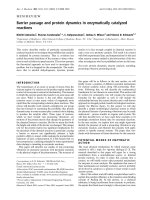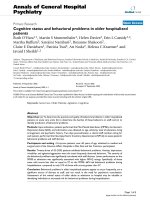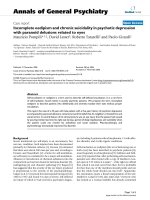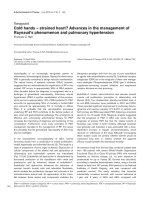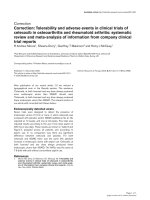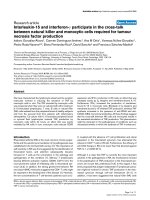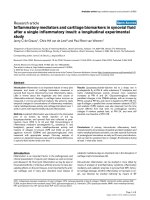Báo cáo y học: " Personality disorders and psychosocial problems in a group of participants to therapeutic processes for people with severe social disabilities" docx
Bạn đang xem bản rút gọn của tài liệu. Xem và tải ngay bản đầy đủ của tài liệu tại đây (254.28 KB, 20 trang )
This Provisional PDF corresponds to the article as it appeared upon acceptance. Fully formatted
PDF and full text (HTML) versions will be made available soon.
Personality disorders and psychosocial problems in a group of participants to
therapeutic processes for people with severe social disabilities
BMC Psychiatry 2011, 11:192 doi:10.1186/1471-244X-11-192
Carlos Salavera ()
Jose M Tricas ()
Orosia Lucha ()
ISSN 1471-244X
Article type Research article
Submission date 20 January 2011
Acceptance date 11 December 2011
Publication date 11 December 2011
Article URL />Like all articles in BMC journals, this peer-reviewed article was published immediately upon
acceptance. It can be downloaded, printed and distributed freely for any purposes (see copyright
notice below).
Articles in BMC journals are listed in PubMed and archived at PubMed Central.
For information about publishing your research in BMC journals or any BioMed Central journal, go to
/>BMC Psychiatry
© 2011 Salavera et al. ; licensee BioMed Central Ltd.
This is an open access article distributed under the terms of the Creative Commons Attribution License ( />which permits unrestricted use, distribution, and reproduction in any medium, provided the original work is properly cited.
Personality disorders and psychosocial problems in a group of participants
to therapeutic processes for people with severe social disabilities
Carlos Salavera
1
, José M. Tricás
2
, Orosia Lucha
2
(Universidad de Zaragoza, España)
1
Departament de Psychology and Sociology. Education Faculty, Zaragoza University, C/ San Juan Bosco, 7.
50009 Zaragoza, Spain
2
Physiotherapy Research Unit, Zaragoza University, C/ Domingo Miral s/n, 50009 Zaragoza, Spain
1
Correspondence: Departamento de Psicología y Sociología. Universidad de Zaragoza. San
Juan Bosco, 7. 50009 Zaragoza (España). E-mail:
ABSTRACT:
Background: Homeless people have high dropout rates when they participate in
therapeutic processes. The causes of this failure are not always known. This study
investigates whether dropping-out is mediated by personality disorders or whether
psychosocial problems are more important.
Method: Eighty-nine homeless people in a socio-laboral integration process were
assessed. An initial interview was used, and the MCMI II questionnaire was applied to
investigate the presence of psychosocial disorders (DSM-IV-TR axis IV). This was
designed as an ex post-facto prospective study.
Results: Personality disorders were very frequent among the homeless people
examined. Moreover, the high index of psychosocial problems (axis IV) in this
population supported the proposal that axis IV disorders are influential in failure to
complete therapy.
Conclusion: The outcomes of the study show that the homeless people examined
presented with more psychopathological symptoms, in both axis II and axis IV, than the
general population. This supports the need to take into account the comorbidity
between these two types of disorder among homeless people, in treatment and in the
development of specific intervention programs. In conclusion, the need for more
psychosocial treatments addressing the individual problems of homeless people is
supported.
Background:
Homeless people live in city streets and temporary shelters because of
successive sudden and traumatic rupture of family, social and labor ties [1]. They form
one of the most vulnerable and disadvantaged groups in society [2]. Their situation is
also related to a low quality of life and to a high rate of physical and psychic diseases
[3]. They suffer obvious mental deterioration because they inhabit the street [4,5,6] and
they are considered to represent the maximum level of social exclusion in modern
society [7].
Personality disorders (PD) are the mental pathologies most obviously present in
this population. Sometimes several disorders coexist [8]. It also must be considered
that such psychosocial conditions existed prior to the individuals’ departure from their
homes [9].
There has been extensive work on how to deal with PD [10,11,12,13,14].
Recently, there has also been much research on PD in populations being treated for
addictions [15,16,17]. Treatments for psychosocial disorders remain less fully
developed because of the possible variables in community treatment [18].
In this study, our aim was to investigate which factors (psychosocial or
personality disorders) are more important contributors to treatment dropout among
homeless people.
Methods
Participants
The sample consisted of homeless people (N=89) who registered at the center
for the homeless under consideration. The 89 subjects in the study were selected from
among 96 people who underwent an inclusion assessment for homeless people based
on the following criteria; (a) being homeless; (b) more than two months’ stay in the
center; (c) voluntary participation in the study; and (d) a long enough stay to complete
the study.
Assessment measurements
- Initial assessment interview: Initially, a structured individual interview was
conducted in order to make a diagnosis. In this interview the most significant
data were collected: age, marital status, educational level, age and cause of
onset of transient life, familial relationships, alcohol and drug consumption and
previous psychological treatment.
- Millon Multiaxial Clinical Inventory MCMI-II [19]: The MCMI-II provides
theoretically derived measures which predict diagnostic probabilities and a
wide range of cognitive, affective, perceptual, interpersonal, and behavioral
clinical attributes (Millon, 1987). The questionnaire comprises 175 questions,
with true or false choices, which are answered in 25-30 minutes.
- Axis IV disorder evaluation interview of DSM-IV-TR: A structured individual
interview was carried out in order to diagnose the problems in relation to axis
IV psychosocial disorders. In this interview, data about different factors of the
problem were collected: problems with the family of origin or the created
family, problems at school, work, home, economic, health or legal problems.
Procedure
The study was conducted through interviews carried out by clinical
psychologists; they performed the Initial Assessment interview. In order to measure the
disorders in axis II of DSM-IV-TR, after analyzing different personality assessment
tools, the MCMI II Millon Multiaxial Clinical Inventory was selected because it is quick
and easy to apply and provides an opportunity to obtain more relevant information
about the subjects. Finally, to assess problems in axis IV of DSM-IV-TR (psychosocial
disorders), a complementary diagnostic interview was carried out, in which the
problems relating to that axis were analyzed (family of origin, created family, school,
work, home, economic, health and legal).
All the subjects were males, over 18 and with sufficiently long pathways in the
treatment process for the data to be collected and an objective assessment made.
They also signed an informed consent form for participation in the research.
Both the interviews and the MCMI II were applied and corrected by the two
clinical psychologists. The study considered the presence of a personality disorder
when the score in the rate-base (RB) of the MCMI II was more than 74. Also, in order
to measure adherence to treatment and achieve honesty and reliability in the interviews
and tests, all cases were examined after two months’ stay in the center.
For statistical analysis of the data, the statistical program SPSS 15.0 version
was used. A descriptive analysis was performed (maxima, minima, averages and
standard deviation) for each of the variables. In all cases the significance level used
was 5%. Crossed variables and bilaterally correlated analysis were also carried out.
The study conformed to the policies established by the Code of Ethics of the World
Medical Association (Declaration of Helsinki) and ethics approval was obtained from
the Doctoral Commission of the University of Zaragoza.
Results
In this section (table 1), the large number of young homeless people in the
integration process stands out; nearly one in every four subjects was younger than 30.
The percentage of persons older than 50 years was surprisingly low (7.9%). This could
indicate the low interest of people at this age in integration processes, an obvious
result of the damage suffered during their stay in the street and their disillusionment
with previous processes (Cabrera, 1998; Salavera et al, 2009). Regarding their marital
status, although 60.7% (N=47) were single parents, with or without maintenance
obligations, the low number of people with a partner during their stay at the center
(3.3%) stands out, and so does the high number of breakups among people who have
had a partner (36%). But above all, the number of people who had not established a
stable relationship with their partner stands out. These data are consistent with other
studies [20]. From the research done, a low level of schooling can be seen, mainly
because of early incorporation into the labor market.
Moreover, organic problems in the subjects were analyzed (figure 1), alcohol
and drugs abuse high incidence were observed, as well as a low frequency of cognitive
damage.
Axis II variables
Table 2 shows the Millon Multiaxial Clinical Inventory MCMI-II results for the
current study. The antisocial (35.1%, N=27), dependent (29.9%, N=23), compulsive
(28.6%, N=22) and narcissistic (28.6%, N=22) disorders show higher scores, RB>74. It
is remarkable that some subjects gave test results showing they could have one or
more subscales with high scores.
The number of personality disorders was also analyzed in every subject (figure
2). Some subjects in homeless integration treatment had no personality disorder
(19.5% of cases, N=15), but some presented one (23.4%, N=18), two (18.2%, N=14) or
three or more (39%, N=30) personality disorders.
Axis IV Variables
Each participant was interviewed in order to diagnose the various disorders in
axis IV (DSM-IV-TR). This was evaluated separately by both clinical psychologists to
ensure inter-tester reliability (table 3).
Moreover the importance both axes (II and IV) in the rate of dropping out from
treatment processes was analyzed. Among the participants in the study, 33 (37.08%)
failed to complete and 56 (62.92%) completed the process. In table 4, the disorders of
the subjects are indicated, and also the percentages of total dropouts and integrations.
Finally, correlations between organic, personality and psychosocial disorders
were analyzed (table 5).
The high prevalence of personality disorders (75.3%), the high number of
personality disorder / person present in the sample (X=2.84) and the homogeneity
presented in the psychosocial problems in the population (remember that issues such
as home environment, economy, employment status are part of the definition of
homelessness), makes difficult to attribute to personality disorders, valued in general,
the presence of psychosocial disorders. Something similar happens in the case of
organic disorders and their relation to psychosocial problems. In this case, the sample
(homeless people for a long time), has an important organic impairment. Analyzing the
correlations between personality disorders, with organic and disorders (table 5), we
conclude that they are so linked in the sample that it is difficult to establish causal
relationships between them other than those outlined in this table.
Discussion and conclusions
This study focused on identifying the cause of dropping out from the integration
process, evaluating whether the personality disorders or the psychosocial problems
found in homeless people were more prominent.
According to the data, the typical profile of a homeless person would be one
with more than one PD (X=2.84), who usually presents with psychosocial problems,
mostly home and economic problems in the sample studied, but also with serious
problems in axis IV. The axis II disorders from which the homeless people suffered
belonged mainly to the group of interpersonal and ambivalent conflicting problems. The
disorders most commonly found were: antisocial: 38.2%; compulsive: 32.6%;
dependent: 28.1%; narcissistic and schizoid: 27.0%, very similar percentages to those
found in previous studies [15, 21].
As expected, the most common disorders in the sample were related to
interpersonal problems (dependent, narcissistic and antisocial), along with one
belonging to the group of ambivalent personalities with conflicts (compulsive). This
explains the correlation between these types of PD and the psychosocial problems as
the main cause for dropping out. This, analyzed using Millon’s typology [22], shows a
person looking for independence not by his own self-confidence but by the distrust of
others, with frequent failures in their obligations and with irresponsible and
transgressive behavior (ASPD), expressively arrogant and interpersonally exploitative,
ignoring coexistence rules (NPD), with serious internal divisions from which he cannot
escape (CPD), avoiding adult responsibilities and self-assertiveness, and with a lack of
functional competence (DPD)
The disorder most prevalent in the study population (one in every three
subjects) was the antisocial personality disorder (ASPD); in the normal population it
appears in only 3%, which rises to 75% among prisoners [23].
It is surprising that, along with ASPD, there was a high prevalence of the
dependent personality (DPD). This was found in 29.9% of the subjects, three times the
incidence obtained in previous studies. It is found in 3% of the clinical population and in
10% of the general population [14]. The fact that all the subjects were male makes the
implication of this result even more far reaching. Subjects with DPD adhered well to
treatment, with a low dropout rate.
In this study it was shown that 28.6% (N=22) of the subjects can be considered
to have a narcissistic personality disorder (NPD), more than reported in previous
studies. This can be explained because in pathological narcissism, self-esteem is
disturbed [24] and becomes fragile [25], something that occurs in homeless people.
The prevalence of the narcissistic personality disorder in a general population has been
reported to be 1% [26]. Other researchers have found a greater NPD rate [27], for
instance 22% of the adult clinical population, and both are far from the results of our
study.
As a preliminary conclusion, a high prevalence of PD was observed in this
study, well above the rate found from epidemiological data concerning the general
population [28].
Regarding the disorders in axis IV, every subject experienced home and
economic difficulties, typical features of homeless people. Moreover, work problems,
and difficulties with created family or the person’s legal processes, have a marked
impact on dropping-out, even greater than the personality disorders (axis II). This
finding is consistent with studies concerning how the existence of a personality disorder
influences the treatment dropout rate [29]. It can be said that the subjects in the sample
with more than one type of personality disorder have a worse prognosis, and
comorbidity between axes II and IV is a complicating factor.
The outcomes of the study show that the homeless people examined present
with greater psychopathological symptoms, both in axis II and in axis IV, than the
general population. This determines the rate of dropping-out from treatment processes.
Our findings indicate the need to take the comorbidity between the two types of
disorders in homeless people into account, both in treatment and in the development of
specific intervention programs.
List of abbreviations
ASPD: Antisocial Personality Disorder, CPD: Compulsive Personality Disorder, DPD:
Dependent Personality Disorder, DSM-IV-TR: Diagnostical and Stadistical Manual of
Mental Disorders, MCMI II: Millon Clinical Multiaxial Inventory, NPD: Narcissistic
Personality Disorder, PD: Personality Disorder, SPSS: Statistical Package for the
Social Sciences
Competing interests
The authors declare that they have no competing interests.
Authors' contributions
CSB conceived the study and participated in its design. JMTM contributed to the
acquisition of data and to the drafting and revision of the manuscript. MOLL
participated in the analysis and interpretation of data. All authors read and approved
the final manuscript.
References
1. Cabrera, P.J., Malgesini, G. & López, J.A. (2003). Un techo y un futuro: buenas
prácticas de intervención social con personas sin hogar. Barcelona: Icaria.
2. Pascual, J.C., Malagón, A., Arcega, J.M., Gines, J.M., Navinés, R., Gurrea, A.,
García-Ribera, C. & Bulbena, A. (2008). Utilization of psychiatric emergency
services by homeless persons in Spain, General Hospital Psychiatry, 30, (1), 14-
19.
3. Folsom, D. F., Hawthorne, W., Lindamer, L., Gilmer, T., Bailey, A., Golshan, S.,
García, P., Unützer, J., Hough, R. & Jeste, D.V. (2005). Prevalence and risk
factors for homelessness and utilization of mental health services among 10,340
patients with serious mental illness in a large public mental health system.
American Journal of Psychiatry, 162, 370-376.
4. Cabrera, P. J. (2000). La Acción Social con personas sin hogar en España.
Madrid: Cáritas.
5. Muñoz, M., Vázquez, J.J., Panadero, S. & Vázquez, C. (2003). Características de
las personas sin hogar en España: 30 años de estudios empíricos, Cuadernos de
Psiquiatría Comunitaria, 3, (2), 100-116.
6. Salavera, C., Puyuelo, M. & Orejudo, S. (2009). Trastornos de personalidad y
edad: Estudio con personas sin hogar, Anales de Psicología, 25, (1), 261-265.
7. Twenge, J.M., Baumeister, R.F., DeWall, C.N., Ciarocco, N.J. & Bartels, J.M.
(2007). Social exclusion decreases prosocial behavior. Journal of Personality and
Social Psychology, 92, 56-66.
8. Salavera, C. (2009). Personality disorders in homeless people, International
Journal of Psychology and Psychological Therapy, 9, (2), 275-283.
9. Salavera, C., Puyuelo, M., Tricás, J.M. & Lucha, O. (2010). Comorbilidad de
trastornos de personalidad: Estudio en personas sin hogar, Universitas
Psychologica, 9, (2) 457-467.
10. Davidson, K.M. (2008). Cognitive-behavioural therapy for personality disorders,
Psychiatry, 7, (3), 117-120.
11. Gunderson, J.G. & Gabbard, G.O. (Coords.) (2000). Psychotherapy of personality
disorders. Washington, DC.: American Psychiatric Press.
12. Millon, T. & Davis, R.D. (1998). Trastornos de la personalidad. Más allá del DSM-
IV. Barcelona: Masson.
13. Quiroga, E. & Errasti, J.M. (2001). Tratamientos psicológicos eficaces para los
trastornos de personalidad. Psicothema, 13 (3), 393-406.
14. Rubio, V. & Pérez, A. (2003). Trastornos de la personalidad. Madrid: Ed. Elsevier.
15. Fernández-Montalvo, J., López-Goñi, J.J., Landa, N., Illescas, C., Lorea. I. &
Zarzuela, A. (2004). Trastornos de personalidad y abandonos terapéuticos en
pacientes adictos: resultados en una comunidad terapéutica, International Journal
of Clinical and Health Psychology, 4, (2), 271-283.
16. Navas, E. & Muñoz, J.J. (2006) Características de personalidad en
drogodependencias, Revista Chilena de Psicología Clínica, 1, 51-61.
17. Pedrero, E.J. (2009). Dimensiones de los trastornos de personalidad en el MCMI-II
en adictos a sustancias en tratamiento, Adicciones: revista de socidrogalcohol, 21,
(1), 29-38.
18. Dixon, L., Weiden, P., Torres, M. & Lehman, A. (1997). Assertive community
treatment and medication compliance in the homeless mentally ill. American
Journal of Psychiatry, 154, 1302 - 1304.
19. Millon, T. (1999). MCMI-II: Inventario Clínico multiaxial de Millon. Manual (2ª ed.
Revisada). Madrid: TEA.
20. Cabrera, P.J. (1998). Huéspedes del Aire. Sociología de las personas sin hogar en
Madrid. Madrid: Universidad Pontificia Comillas.
21. Bricolo, F., Gomma, M., Bertani, M. y Serpelloni, G. (2002). Prevalencia de
trastornos de personalidad en una muestra de 115 clientes con trastornos por uso
de drogas. Adicciones, 14, 491-496.
22. Millon, T., Grossman, S., Millon, C., Meagher, S. & Ramnath, R. (2006).
Trastornos de la personalidad en la vida moderna, 2ª edición. Barcelona: Masson.
23. Widiger T y Seidlitz L (2002). Personality, psychopathology, and aging. Journal of
Research in Personality, 36, 335-362.
24. Kernberg, O. (1989). Narcissistic Personality Disorder, Philadelphia: Saunders.
25. Ronningstam E, Gunderson J y Lyons M (1995). Changes of pathological
narcissism. American Journal of Psychiatry, 152, 253-257.
26. Zimmerman, M. y Coryell, W.H. (1990). Diagnosing personality disorders in the
community. Archives General of Psychiatry, 47, 145-149.
27. Morey, L. C., & Jones, J. K. (1998). Empirical studies of the construct validity of
narcissistic personality disorder. In E. F. Ronningstam (Ed.), Disorders of
narcissism. Diagnostic, clinical, and empirical implications (pp. 351-373).
Washington, DC: American Psychiatric Press.
28. American Psychiatric Association, (2004). Manual diagnóstico y estadístico de los
trastornos mentales (4ª ed. Revisada). Barcelona: Ed. Masson.
29. Chiesa, M., Drahorad, C. & Longo, S. (2000). Early termination of treatment in
personality disorder treated in a psychotherapy hospital: Quantitative and
qualitative study, British Journal of Psychiatry, 177, 107-111.
Tables
Table 1. Sociodemographic features (N=89)
AGE
N %
Average
37,86
Range
(22-52)
<30 years
19 (21,3%)
30-39 years
32
(36%)
40-49 years
31
(34,8%)
>50 years
7
(7,9%)
MARITAL STATUS
Sigles 54 (60,7%)
Separated/Divorced 32 (36%)
De facto partnership
3 (3,3%)
SCHOOLING
School Certificate 31 (35,2%)
EGB 42 (47,2%)
FP 10 (11,2%)
BUP 5 (5,6%)
Table 2. MCMI II Scores (N=89)
Minimum
Maximu
m
Averag
e
S.D.
F Signif. % RB>74
Schizoid
0 117 59,98 26,543
3,925 ,051 24 (27%)
Phobic
2 103 50,82 29,466
1,772 ,187 22 (24,7%)
Dependent
0 108 55,93 29,523
6,670 ,011 25 (28,1%)
Histrionic
5 100 51,66 24,518
1,039 ,311 18 (20,2%)
Narcissist
0 109 56,61 24,982
,608 ,438 24 (27%)
Antisocial
0 121 65,84 28,324
2,893 ,093 34 (38,2%)
Aggressive
0 120 54,64 28,161
,828 ,365 19 (21,3%)
Compulsive
5 120 65,82 26,168
1,268 ,263 29 (32,6%)
Passive
0 103 41,93 27,971
1,632 ,205 13 (14,6%)
Self-destructive
0 109 52,28 25,259
,090 ,765 12 (13,5%)
Schizotipical
5 117 55,70 25,988
2,112 ,150 18 (20,2%)
Limit
0 112 45,48 27,667
1,462 ,230 11 (12,4%)
Paranoid
8 118 62,43 22,869
,061 ,805 19 (21,3%)
Table 3. Psychosocial disorders (axis IV) present in the subjects studied.
Present
problems
F Sig.
Origin family problems 73 (82%) 5,623 ,020
Created family problems 38 (42,7%) ,229 ,633
Shool problems 31 (35,2%) ,420 ,519
Work problems 36 (40,4%) 16,643 ,000
Home problems 89 (100%) . .
Economical problems 89 (100%) . .
Health problems 33 (37,1%) 1,569 ,214
Arrested 48 (53,9%) ,275 ,601
Table 4. Dropouts according to axis II and IV (N=33)
Disorders seen in
dropouts
Dropouts in relation to
the total simple size
Schizoid 12 (36,36%) 12 (13,48%)
Phobic 10 (30,30%) 10 (11,23%)
Dependent 4 (12,12%) 4 (4,49%)
Histrionic 8 (24,24%) 8 (8,98%)
Narcissist 11 (33,33%) 11 (12,35%)
Antisocial 16 (48,48%) 16 (17,97%)
Aggressive 7 (21,21%) 7 (7,86%)
Compulsive 10 (30,30%) 10 (11,23%)
Passive 7 (21,21%) 7 (7,86%)
Self-destructive
6 (18,18%) 6 (6,74%)
Schizotipical 9 (10,11%) 9 (10,11%)
Limit 7 (21,21%) 7 (7,86%)
Paranoid 10 (30,30%) 10 (11,23%)
Origin family 10 (30,30%) 10 (11,23%)
Created family 20 (60,60%) 20 (11,23%)
School 13 (39,39%) 13 (14,60%)
Work 22 (66,66%) 22 (24,71%)
Home 33 (100%) 33 (100%)
Economical 33 (100%) 33 (100%)
Health 15 (45,45%) 15 (16,85%)
Arrested 19 (57,57%) 19 (21,34%)
Table 5. Correlations between personality, organic and psychosocial disorders
Origin family Created
family
Scho
ol
Work Home Economic Health
Arrested
Anxiety
Hysteriform
Hypomania -,238(*)
Dysthymia ,614(**) ,300(**)
Alcohol abuse -,260(*)
Drugs abuse -,383(**)
Thought
psychotic
Depression ,267(*)
Organic
disorders
Disorder
delirious
Schizoid ,241(*)
Phobic ,261(*)
Dependent
Histrionic
Narcissistic
Antisocial
Aggressive
Compulsive ,236(*)
Passive
Self-destructive ,270(*
)
Schizotypical ,212(*
)
,212(*)
Limit
Personalit
y disorders
Paranoid
Figures
Figure 1. Organic disorders in the population
Figure 2. Personality disorders in the population
Figure 1
Figure 2
